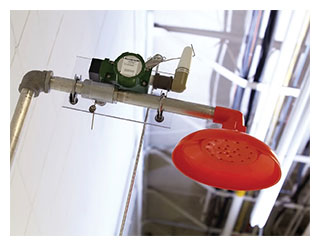‘It all starts with a sensor’ – the importance of sensors in IoT
Hardware Pioneers is a group of over 6,000 startup founders, executives, engineers and developers that come together every month in London to listen to industry talks and establish new connections. Last week, Electronic Specifier attended Hardware Pioneers’ latest event entitled ‘All About IoT sensors’. The evening consisted of presentations, community announcements and a networking session.
Leslie Neill, Senior Product Manager, EMEA, Honeywell, kicked off proceedings with his talk ‘It all starts with a sensor’. Neill is responsible for Sensing and IoT business for the EMEA region at Honeywell. He covers all sensing and electro-mechanical products that are used in aerospace, industrial, medical and transportation applications within the Honeywell Sensing and Productivity Solutions Business Unit.
Honeywell invents and manufactures technologies to address tough challenges linked to global macrotrends such as safety, security, and energy. With approximately 129,000 employees worldwide, including more than 6,000 software engineers, Honeywell has a strong focus on quality, delivery, value, and technology in everything they make and do. According to Neill, “we’d been in IoT for years, we just didn’t know it”.
Neill’s talk highlighted the important elements of IoT solutions, specifically sensors. A sensor is a foundational element of IoT because, in order for an IoT solution to work, a manual or environmental input is always required.
We can find sensors everywhere. The real challenge is now in miniaturisation; how to reduce both component size and power consumption. The latter is vital in standalone and wireless hardware because they are expected to last for a long time without maintenance.
As technologies become more complex, design engineers are under increased pressure to go-to-market quickly, manage shorter product lifecycles, and do more with less. Neill gave the example of the mobile phone market; consumers constantly demand lighter, more powerful products with greatly increased capabilities, and they expect to see new models often.
In order to succeed, design engineers must also choose the right sensor for the application space they are working in. To help, Honeywell works in a range of application spaces including medical, industrial, aerospace and transportation.
 As more and more countries experience an ageing population, the medical market becomes increasingly important. Neill explained that there is a need for smaller sensors that can be implemented in wearable IoT solutions, and sensors that can be swallowed or even embedded into the body.
As more and more countries experience an ageing population, the medical market becomes increasingly important. Neill explained that there is a need for smaller sensors that can be implemented in wearable IoT solutions, and sensors that can be swallowed or even embedded into the body.
With regards to the industrial market, Neill discussed a sensor Honeywell designed for a safety shower in a chemical plant (pictured). The switch detects when the shower is activated, which in turn alerts the team so that they can deploy a medical team. The wireless sensor can run for two to three years and requires no maintenance.
In the aerospace industry, sensors are required to trace parts and ensure maintenance has been carried out in the correct sequence and following the right process. RFID tags can track and trace the validity of aircraft parts.
Neill also explained that in the transportation sector there is always a risk involved when transporting perishable goods from A to B. If the correct sensor is utilised, the temperature of the goods can be tracked and a certificate of authenticity will be provided upon reaching the destination. This ensures the goods are fit for sale.
According to Neill, sensor technologies will help drive significant benefits and create an intelligent experience for consumer, businesses, and our society as part of a more connected world. He continued: “We are just at the beginning of things … just scratching the surface.” Sensors can provide valuable information about the real time applications for your product. They can indicate whether it is too active or inactive, therefore saving you money in the long term.
Honeywell can help designers looking to scale up the design of their products. While your product may work after adjustment on the prototype bench, this level of adjustment is not feasible on a larger scale. A cheap unamplified uncalibrated board mounted pressure centre may look cost effective in your bill of material (BOM), but calibration is not practical when you scale up.
Honeywell reviews the total cost of your design, not just the BOM cost, and the company considers a range of factors including power saving techniques and how to achieve the smallest practical size. The latter refers to reaching the functionality that you need – no more, no less. In addition, Honeywell focuses on support and availability, working closely with distributors including Mouser to ensure products are shipped in less than one day.
Neill was keen to clarify that Honeywell is not competing against its customers. He described the IoT as a gold rush, with Honeywell providing the picks and shovels to go digging for gold.









